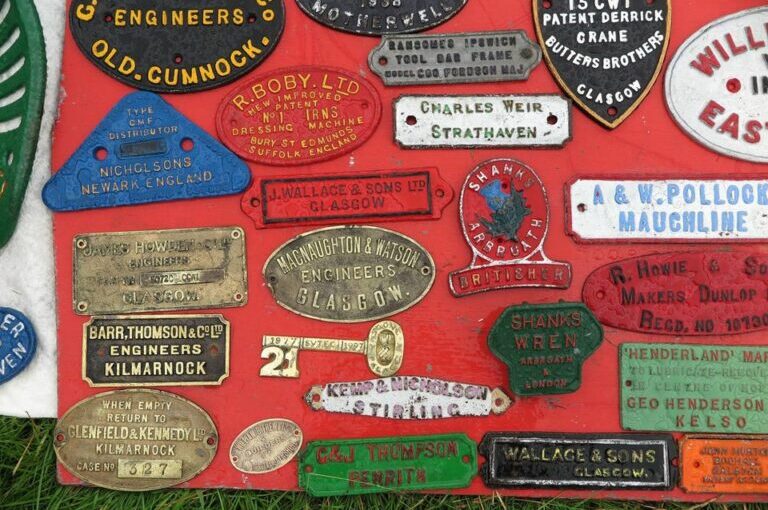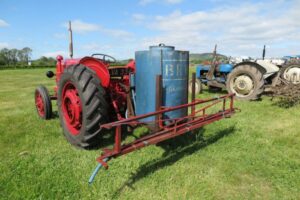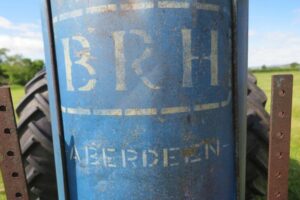A number of premises belonging to the Scottish agricultural implement makers went on fire. Some of the fires were very destructive with the complete loss of premises, or significantly affected production of manufactures.
The accounts of the fires in the newspaper press sometimes include detailed accounts of the premises and the businesses which are not recorded elsewhere. These accounts are worth quoting at length for the insights they provide.
The Scotsman provided an account of a fire of the implement works of James Gordon, King Street, Castle Douglas in its columns on 29 May 1911:
“Fire at castle Douglas
An outbreak of fire occurred at the implement works of Mr James Gordon, King Street, Castle Douglas, on Friday night. The fire was confined mostly to the engine-shed, in which were several barrels containing paraffin oil. These became ignited, and for a time the fire seemed to have a complete mastery, and the whole workshop was in imminent danger. The flames leapt to the roof, which was entirely composed of glass, and the glare attracted a large crowd. After much exertion the flames were got under, but not before considerable damage was done, the large engine-shed and glass roof of an outer building being demolished. The damage is covered by insurance.”
A destructive fire affected the Cragshaw premises of Barclay, Ross, & Hutchison, agricultural implement makers, Aberdeen in May 1920. The Scotsman of 10 May, suggested that the cost of the fire amounted to between £6,000 and £10,000. The Aberdeen press and journal provided a detailed account of the fire that provides detailed information about the company’s Cragshaw Works which were famous throughout the works – and not only in the north-east of Scotland:
“Big fire at Aberdeen Implement Works
Destruction put at £6,000.
The Aberdeen City Fire Brigade were out three times on Saturday. Their first call was in the early morning to a destructive blaze at Craigshaw, just beyond the city boundary at Torry, damage being done to the premises and stock there of Messrs Barclay, Ross, and Hutchison, one of the best known firms of agricultural implement makers in Scotland, to the extent of about £6,000.
The Craigshaw outbreak was observed between two and three o’clock in the morning, and it was only after about five hours’ hard work on the part of the members of the Fire Brigade that the flames were got under. The premises, which are situated close to the railway line, consist of a large range of buildings, including a corrugated iron structure 168 feet long, 30 feet broad, and 14 feet high. And a stone and lime erection 100 feet long and 46 feet broad. The corrugated iron building was practically gutted, while the other, particularly at the south end, was badly damaged. The buildings included a millwright’s shop, stores, offices, blacksmith’s shop, engineer’s shop, dressed wood store, etc.
It is not known how the outbreak originated, but it is thought to have started in the paint shop. The signalman on duty in the railway cabin beside the railway bridge at Craigshaw was the first to observe the outbreak. He immediately telephoned for the fire brigade, which was promptly on the scheme, under Firemaster Inkster. By the time the brigade arrived, however, the flames were bursting through the roof of the corrugated iron building, and by three o’clock the erection was practically ablaze from end to end.
The firemen devote d their energies to preventing the flames from spreading to the stone and lime structure. They were successful in saving the north end, but at the other end, which adjoins the corrugated iron building, the flames did considerable damage. It was not until seven o’clock in the morning that all danger was past. Two telegraph standards were badly damaged.
The works at Craigshaw were the largest of their kind in the north of Scotland. Threshing mills, manure distributors, oil engines, and a variety of other agricultural machinery and implements which were being prepared for the exhibition in the showyard of the Highland and Agricultural Society at Aberdeen in July were destroyed.
The damage is covered by insurance.”
Another fire was reported by the Dundee courier, on 22 July 1925. It affected the Culthill Agricultural Implement Works, Caputh, owned by Messrs J. D. Allan & Sons, one of the important Perthshire makers:
“Farm fire near Caputh
Extensive damage to implement works
Agricultural show exhibits destroyed
Extensive damage was caused by an outbreak of fire which occupied at a late hour last night at the Culthill Agricultural Implement Works, Caputh, owned by Messrs J. D. Allan & Sons.
Culthill is on the well-known estate of Glendelvine. The fire was discovered by one of the workers in a field on Culthill Farm, tenanted by Mr J. D. Allan, who is also sole proprietor of the implement works. He observed smoke issuing from nearby, but at first thought it was cattlemen burning some rubbish.
On closer inspection, however, he found that the smoke was issuing from the wood department of the works, and immediately summoned Mr Allan. Mr Allan had retired to bed, but on being roused and seeing the danger, proceeded to Glendelvine, and had the Glendelvine hose and hydrant attached to the estate supply.
By this means Mr Allan an several willing workers prevented the flames spreading to byres and other adjoining premises.
Perth Fire Brigade were summoned by the chauffer at Glendelvine House, and were on the scene within half-an-hour of the alarm. The principal damage is caused to machinery and parts of agricultural implements in course of preparation.
Mr Allan was in attendance at the Highland Show last week and had secured, it is understood, a considerable number of orders, and had in course of preparation seventeen carts intended for sale and for exhibition at the forthcoming Perthshire and Angus Shows.
Timber stock saved
A large and valuable stock of seasonal timber was fortunately saved from the flames. Much alarm was caused for a period because of the congested nature of the buildings. Mr Allan employs about fifteen hands and in recent years had developed an extensive business.
The Brigade obtained a plentiful supply of water from a dam about eighty yards distant, and speedily had the flames under control.
The damage, which is only partly covered by insurance, is estimated at fully £1,000.”


